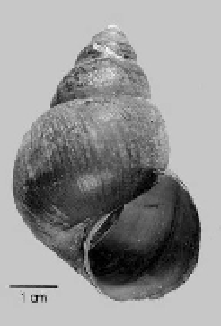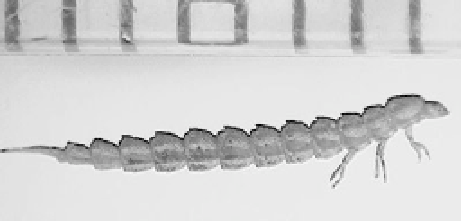Environmental Engineering Reference
In-Depth Information
(a) (b) (c)
(d) (e)
Fig. 10.8
Typical species of the five groups of benthic invertebrates with different functions in the food chain:
(a) Gomphidae (Dragonfly-
predator
); (b) Viviparidae (
scraper
); (c) Hydropsychidae (
collector-filter
); (d) Corbiculidae
(
filter-collector
); and (e) Haliplidae (
shredder
) (See color figure at the end of this topic)
migrating they move between saltwater and freshwater, therefore, need to be able to osmoregulate
efficiently (McKeown, 1984). According to their temperature requirements, species may also generally
be referred to as cold water or warm water and gradations between. Salmonid fish prefer cold and highly
oxygenated water, and, therefore, can generally be found at high altitudes or northern climes. Salmonid
populations are very sensitive to change or deterioration of their habitat, including alteration of flows,
temperature, and substrate quality. They tolerate only very small fluctuations in temperature and only
reproduce under certain conditions. Their reproductive behavior and movements are affected by almost
undetectable changes in temperature. Usually a salmonid spawns by depositing eggs over or between
clean gravel, which remain oxygenated and silt free due to upwelling of currents between the interstitial
spaces. Salmonid populations, therefore, are highly susceptible to many forms of habitat degradation,
including alteration of flows, temperature, and substrate quality.
The general concern and interest in restoring habitats for fish by improving both quality and quantity,
is due to the widespread decrease in numbers of native fish species. With ecological, economical, and
recreational considerations in mind, the importance given to the restoration of fish communities is
increasing. In 1996 approximately 35 million Americans went fishing for recreational purposes resulting
in over $36 billion in expenditures (Brouha, 1997).
Since most recreational fishing is in streams, it is important to restore stream corridors. Restoration
activities have often been focused on improving local habitats, such as fencing or removing livestock
from streams, constructing fish passages, or installing instream physical habitat. However, the success of
these activities, demonstrated by research, has been very small or questionable. Over its life span, a
species needs many resources and has a great range of habitat requirements which were not considered










Search WWH ::

Custom Search